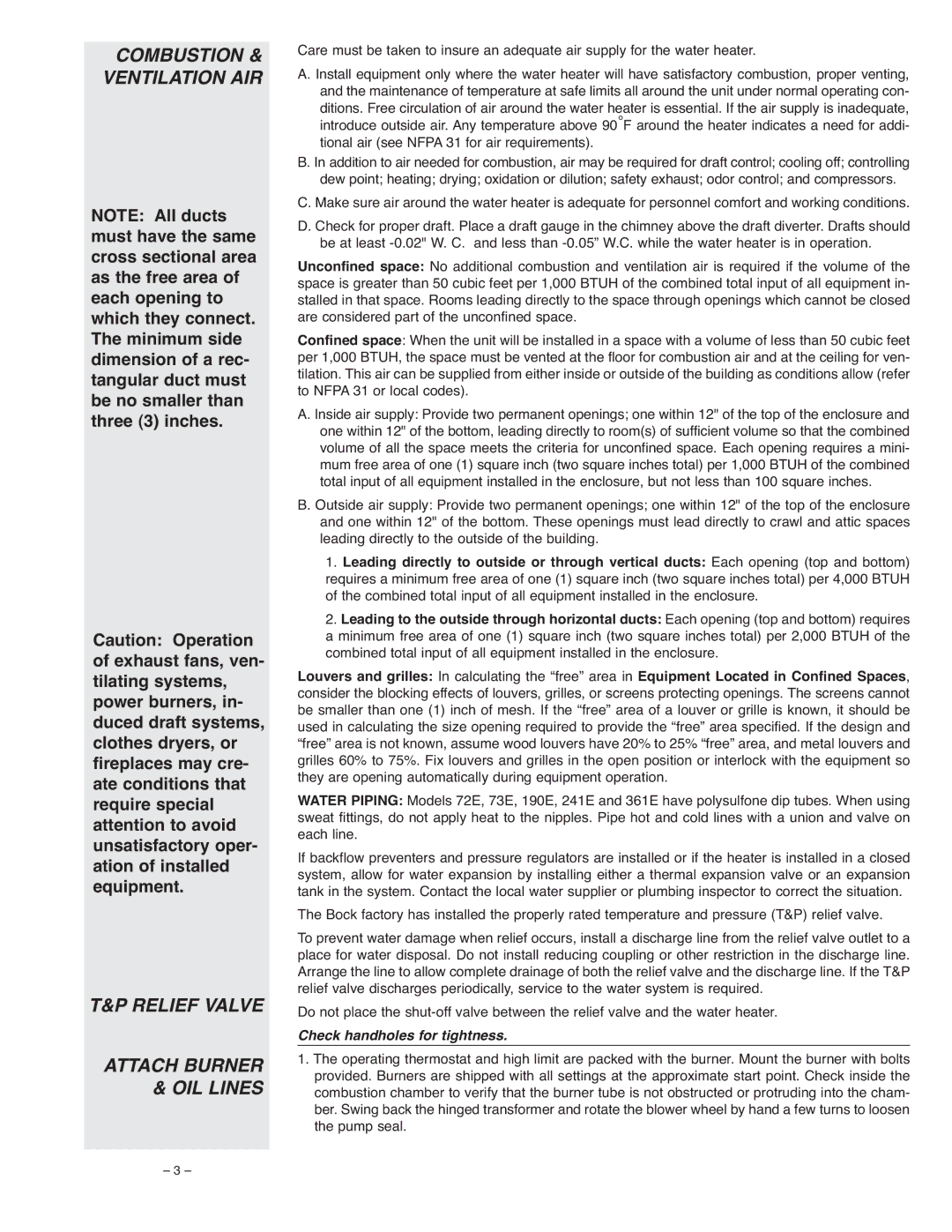Care must be taken to insure an adequate air supply for the water heater.
A. Install equipment only where the water heater will have satisfactory combustion, proper venting, and the maintenance of temperature at safe limits all around the unit under normal operating con- ditions. Free circulation of air around the water heater is essential. If the air supply is inadequate, introduce outside air. Any temperature above 90°F around the heater indicates a need for addi- tional air (see NFPA 31 for air requirements).
B. In addition to air needed for combustion, air may be required for draft control; cooling off; controlling dew point; heating; drying; oxidation or dilution; safety exhaust; odor control; and compressors.
C. Make sure air around the water heater is adequate for personnel comfort and working conditions. D. Check for proper draft. Place a draft gauge in the chimney above the draft diverter. Drafts should
be at least -0.02" W. C. and less than -0.05” W.C. while the water heater is in operation. Unconfined space: No additional combustion and ventilation air is required if the volume of the space is greater than 50 cubic feet per 1,000 BTUH of the combined total input of all equipment in- stalled in that space. Rooms leading directly to the space through openings which cannot be closed are considered part of the unconfined space.
Confined space: When the unit will be installed in a space with a volume of less than 50 cubic feet per 1,000 BTUH, the space must be vented at the floor for combustion air and at the ceiling for ven- tilation. This air can be supplied from either inside or outside of the building as conditions allow (refer to NFPA 31 or local codes).
A. Inside air supply: Provide two permanent openings; one within 12" of the top of the enclosure and one within 12" of the bottom, leading directly to room(s) of sufficient volume so that the combined volume of all the space meets the criteria for unconfined space. Each opening requires a mini- mum free area of one (1) square inch (two square inches total) per 1,000 BTUH of the combined total input of all equipment installed in the enclosure, but not less than 100 square inches.
B. Outside air supply: Provide two permanent openings; one within 12" of the top of the enclosure and one within 12" of the bottom. These openings must lead directly to crawl and attic spaces leading directly to the outside of the building.
1. Leading directly to outside or through vertical ducts: Each opening (top and bottom) requires a minimum free area of one (1) square inch (two square inches total) per 4,000 BTUH of the combined total input of all equipment installed in the enclosure.
2. Leading to the outside through horizontal ducts: Each opening (top and bottom) requires a minimum free area of one (1) square inch (two square inches total) per 2,000 BTUH of the combined total input of all equipment installed in the enclosure.
Louvers and grilles: In calculating the “free” area in Equipment Located in Confined Spaces, consider the blocking effects of louvers, grilles, or screens protecting openings. The screens cannot be smaller than one (1) inch of mesh. If the “free” area of a louver or grille is known, it should be used in calculating the size opening required to provide the “free” area specified. If the design and “free” area is not known, assume wood louvers have 20% to 25% “free” area, and metal louvers and grilles 60% to 75%. Fix louvers and grilles in the open position or interlock with the equipment so they are opening automatically during equipment operation.
WATER PIPING: Models 72E, 73E, 190E, 241E and 361E have polysulfone dip tubes. When using sweat fittings, do not apply heat to the nipples. Pipe hot and cold lines with a union and valve on each line.
If backflow preventers and pressure regulators are installed or if the heater is installed in a closed system, allow for water expansion by installing either a thermal expansion valve or an expansion tank in the system. Contact the local water supplier or plumbing inspector to correct the situation.
The Bock factory has installed the properly rated temperature and pressure (T&P) relief valve.
To prevent water damage when relief occurs, install a discharge line from the relief valve outlet to a place for water disposal. Do not install reducing coupling or other restriction in the discharge line. Arrange the line to allow complete drainage of both the relief valve and the discharge line. If the T&P relief valve discharges periodically, service to the water system is required.
Do not place the shut-off valve between the relief valve and the water heater.
Check handholes for tightness.
1. The operating thermostat and high limit are packed with the burner. Mount the burner with bolts provided. Burners are shipped with all settings at the approximate start point. Check inside the combustion chamber to verify that the burner tube is not obstructed or protruding into the cham- ber. Swing back the hinged transformer and rotate the blower wheel by hand a few turns to loosen the pump seal.

